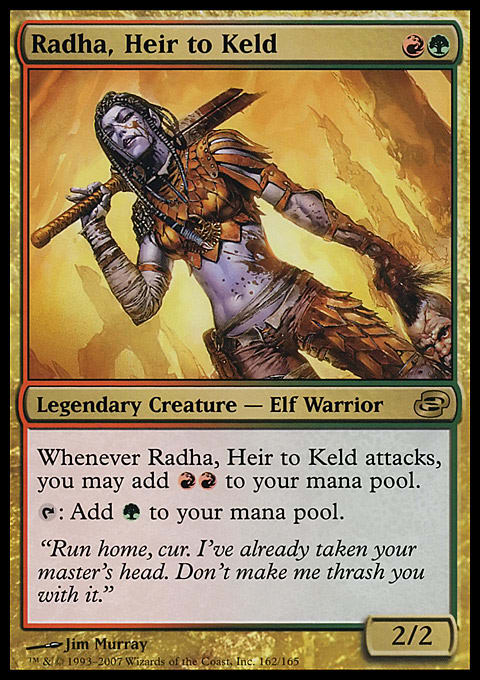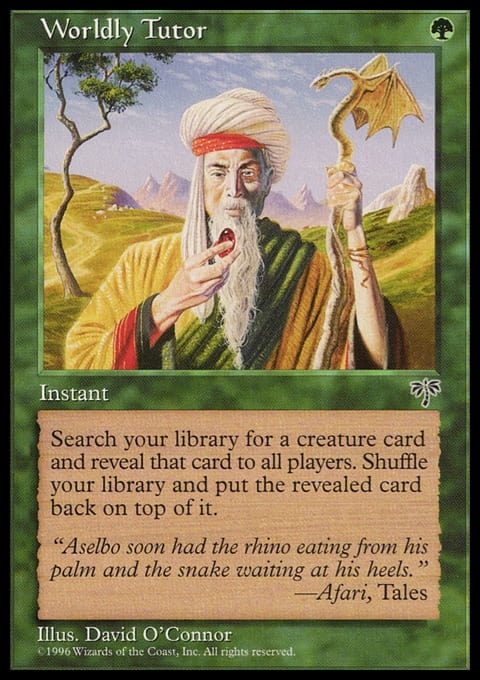Playing Commander is a way for me to unwind. While I am an avowed Spike in two-player formats, when the participant count goes to three or more, my desire to win goes down. My primary goal is to have fun and make memorable games. To do this, I often build decks that are loaded with cards and strategies I want to play. Jarad, Golgari Lich Lord’s is a deck that can win, but it is more about creating a state in which the graveyard, battlefield, and hand all flow together an amorphous continuum. I call it the Golgari Sludge Zone. But this deck does not let my brain relax the same way my Magical soul does. While being able to pluck cards from the graveyard at will is an intensely pleasing experience, it is rather thought-intensive. My preferred style of play puts a lot of emphasis on my decisions, and at times, that can be more stressful than playing to win.
I recognized a little over a year ago and decided I would need to do something different. In order to actually let my mind operate in a lower gear while engaged in a duel, I decided to build a deck that would require less active thought. And I drew inspiration from the dollar bin.
One of my favorite pastimes is perusing the junk-rare box of any dealer. I often uncover cards I forgot had existed and eagerly hand over one hundred cents for the chance to play with this weird and wonderful effects. On one fateful day, I picked up both a Killer Instinct and an Impromptu Raid. The ability to put giant monsters into play for a pittance spoke to a deeply recessed Temur part of my soul. And the cards could even end up in the graveyard, thus earning the Golgari seal of approval. Shortly thereafter, I put together a Riku of Two Reflections deck that focused on winging creatures into play directly from the library and trying to recoup any loss. This deck was loaded with cards the likes of Soothsaying and Crystal Ball to let me work the Oracle of Mul Daya zone, and it ran Spitting Image and Back from the Brink to make sure dead creatures were able to keep doing their jobs. I’m nothing if not a necromantic taskmaster. Eventually, Riku was deconstructed for parts, allowing me to build multiple other decks. But I never forgot the feeling of flipping my giant monsters.
Searching for my mental respite, I recalled this deck. While Riku was never an easy deck to pilot, there were times when my brain could take a breath. Not surprisingly, this usually coincided with when I was operating as a Gruul deck and was choked on blue mana. I proceeded to pick every large and overcosted green and/or red creature and proceeded to build a deck. I pulled out my copy of Radha, Heir to Keld and let her helm the deck. Radha was mostly there for color identity. Tapping for mana did matter, especially when the deck played along a ramp axis or when I wanted extra activations out of Impromptu Raid. Radha accomplished the goal of helping my brain to relax during long sessions of Commander, but it struggled in some other areas.
First, it lacked a coherent identity. If you have been following my Marrow-Gnawer rebuild, you know I care about the essence of a deck and building toward a unified feel. Radha’s was a big, dumb monster deck that was fun to pilot, but it didn’t satisfy the other half of why Alex plays Commander.
I was gifted a focal point when Gatecrash released. I was able to revisit the Gruul Clans and their creature-based bloodrush ways. I decided to push the deck more toward the common saying of, “Gruul Smash.” The deck did smash, but this was just step one. Earlier this year, former manager of this very site Trick Jarrett posted his all-creature Karador, Ghost Chieftain deck. This inspired me to reduce the number of noncreature spells in Radha and force the deck to play along a nearly singular angle of attack.
There was one more piece to the puzzle. After nearly two years in charge, Radha no longer made sense as the leader of this army. Xenagos, God of Revels, however, fit perfectly. XenaGod wants monsters in play and wants them to beat down. This is my current build for Xenagos, God of Revels.
XenaGod ? Commander | Alex Ullman
- Commander (0)
- Creatures (54)
- 1 Acidic Slime
- 1 Avenger of Zendikar
- 1 Bloodfire Colossus
- 1 Bloodshot Cyclops
- 1 Bogardan Hellkite
- 1 Borderland Ranger
- 1 Caldera Hellion
- 1 Conquering Manticore
- 1 Crater Hellion
- 1 Deadwood Treefolk
- 1 Dowsing Shaman
- 1 Dragon Broodmother
- 1 Drumhunter
- 1 Eternal Witness
- 1 Flametongue Kavu
- 1 Furystoke Giant
- 1 Garruk's Packleader
- 1 Gobbling Ooze
- 1 Gruul Ragebeast
- 1 Horned Kavu
- 1 Indrik Stomphowler
- 1 Joraga Treespeaker
- 1 Kessig Cagebreakers
- 1 Llanowar Empath
- 1 Mindclaw Shaman
- 1 Mul Daya Channelers
- 1 Mwonvuli Beast Tracker
- 1 Ogre Battledriver
- 1 Oracle of Mul Daya
- 1 Paleoloth
- 1 Pelakka Wurm
- 1 Rubblehulk
- 1 Sakura-Tribe Elder
- 1 Silklash Spider
- 1 Silverglade Elemental
- 1 Somberwald Sage
- 1 Stalking Vengeance
- 1 Symbiotic Wurm
- 1 Terastodon
- 1 Ulvenwald Tracker
- 1 Viridian Emissary
- 1 Vorapede
- 1 Weatherseed Treefolk
- 1 Woodfall Primus
- 1 Yavimaya Elder
- 1 Yavimaya Granger
- 1 Zealous Conscripts
- 1 Zhur-Taa Druid
- 1 Burnished Hart
- 1 Palladium Myr
- 1 Solemn Simulacrum
- 1 Ruric Thar, the Unbowed
- 1 Verdeloth the Ancient
- 1 Yeva, Nature's Herald
- Planeswalkers (2)
- 1 Domri Rade
- 1 Xenagos, the Reveler
- Spells (6)
- 1 Worldly Tutor
- 1 Call of the Wild
- 1 Greater Good
- 1 Impromptu Raid
- 1 Killer Instinct
- 1 Lurking Predators
- Lands (37)
- 9 Forest
- 8 Mountain
- 1 Command Tower
- 1 Forgotten Cave
- 1 Fungal Reaches
- 1 Gruul Guildgate
- 1 Gruul Turf
- 1 Kazandu Refuge
- 1 Llanowar Reborn
- 1 Mossfire Valley
- 1 Oran-Rief, the Vastwood
- 1 Rogue's Passage
- 1 Rootbound Crag
- 1 Shivan Oasis
- 1 Slippery Karst
- 1 Smoldering Crater
- 1 Temple of Abandon
- 1 Temple of the False God
- 1 Tranquil Thicket
- 1 Winding Canyons
- 1 Keldon Necropolis
- 1 Mikokoro, Center of the Sea
The entire point of this deck is to let me relax while giving me a chance to win. The line of play is relatively simple: Put as many big creatures into play as I can, and overwhelm defenses. While Impromptu Raid and Killer Instinct are my favorite ways to accomplish this, Call of the Wild and Lurking Predators help in this department.
The spells help to keep the deck moving. Worldly Tutor can ensure one of the enchantments will bear fruit and that Domri Rade plays along. Xenagos, the Reveler is here to work with the non-planeswalking aspect and help to generate huge swaths of mana. Finally, Greater Good lets creatures that were going to die anyway turn into extra fuel.
The creatures in this deck have to fill the vacuum created by the absence of spells. Some of these beaters are fairly deep cuts, and some have impressed me quite a bit.
First, Crater Hellion is among my favorite cards in the format. When I opened a few copies in Urza’s Saga, I was in love—the ability to stick a large threat while also sweeping away my opponent’s board was a joy. I didn’t care about paying twice since I had a 6/6. Here, paying the echo does not really matter since the card is usually fated to die thanks to being put into play with a sacrifice rider.
Garruk's Packleader, Drumhunter, Masked Admirers, and Paleoloth keep the cards flowing. Without big-time effects to reload (aside from Greater Good), Xenagos relies on these worshippers to keep bringing friends to the party. Once the drum starts kicking, the dancers follow.
Ruric Thar, the Unbowed and Mindclaw Shaman are the bouncers at the party. With their hatred of spells, they can help keep anyone trying to put a damper on the rager away. The Shaman can be especially nasty when timed right . . . but that is not always an option in this deck. Oh well.
Finally, since this is a deck I am playing, there are cards that care about the graveyard. Here, when someone leaves the soiree, that someone needs to leave something behind. Gobbling Ooze, Bloodshot Cyclops, and Dragon Broodmother turn those who depart into more juice for the party. Horned Kavu can make sure a friend who comes can stay if he or she really wants. Finally, Kessig Cagebreakers makes sure that when the party is over, everyone gets to enjoy the final moments.
How does Xenagos help me relax? My goal is always to play off the top of my deck. When in doubt, I sink mana into Impromptu Raid and hope for the best. Once that happens, I start attacking with impunity at whomever I can. By spreading the pain, I am able to keep the game moving and not draw too much attention to myself. Operating on only creatures, this deck can often present a low profile until the turn it emerges victorious. Empty hands and full battlefields mean all information is known and the worst that can happen is something completely random off the top.
This deck feels excessively Gruul to me, and I love that experience. Not knowing what comes next and having to deal with whatever the deck offers up is a relief. While my brain does not completely shut down, it does gain some much needed respite. Finally, it is viscerally fun to just attack with red and green beasts.
One day maybe I will add a Sneak Attack, but for now, I am more concerned with making the creature suite more impressive. Scourge of the Throne is quite enticing, but I am not sure if there is a way to make sure it sticks around (although if I were keeping true to the Gruul way of life, I would just let it be). What the deck really would love is to have more ways to replicate the effects from the cards that inspired the deck, especially if such a tool were attached to a creature. Courser of Kruphix and Hornet Queen may find their ways into the list once they rotate out of Standard.
Xenagos, God of Revels’s is a different deck for me. Instead of my usual resource-manipulation ways, this deck was built to help me relax and have a good time at the table. Sometimes, I just make a board full of dorks and win. Other times, well, I don’t draw enough cards and run out of gas. Either way, my normally taxed mind is thankful for the change—because Gruul Smash.




























